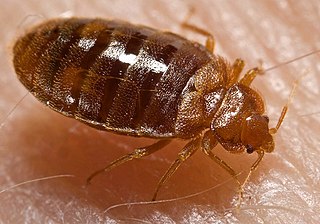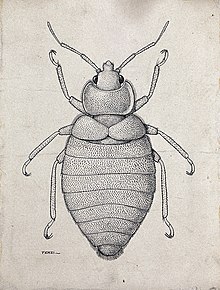
Hemiptera is an order of insects, commonly called true bugs, comprising over 80,000 species within groups such as the cicadas, aphids, planthoppers, leafhoppers, assassin bugs, bed bugs, and shield bugs. They range in size from 1 mm (0.04 in) to around 15 cm (6 in), and share a common arrangement of piercing-sucking mouthparts. The name "true bugs" is often limited to the suborder Heteroptera.

The Reduviidae is a large cosmopolitan family of the suborder Heteroptera of the order Hemiptera. Among the Hemiptera and together with the Nabidae almost all species are terrestrial ambush predators; most other predatory Hemiptera are aquatic. The main examples of nonpredatory Reduviidae are some blood-sucking ectoparasites in the subfamily Triatominae. Though spectacular exceptions are known, most members of the family are fairly easily recognizable; they have a relatively narrow neck, sturdy build, and a formidable curved proboscis. Large specimens should be handled with caution, if at all, because they sometimes defend themselves with a very painful stab from the proboscis.

Bed bugs are parasitic insects from the genus Cimex, who are micropredators that feed on blood, usually at night. Their bites can result in a number of health impacts including skin rashes, psychological effects, and allergic symptoms. Bed bug bites may lead to skin changes ranging from small areas of redness to prominent blisters. Symptoms may take between minutes to days to appear and itchiness is generally present. Some individuals may feel tired or have a fever. Typically, uncovered areas of the body are affected. Their bites are not known to transmit any infectious disease. Complications may rarely include areas of dead skin or vasculitis.

The Cimicidae are a family of small parasitic bugs that feed exclusively on the blood of warm-blooded animals. They are called cimicids or, loosely, bed bugs, though the latter term properly refers to the most well-known member of the family, Cimex lectularius, the common bed bug and its tropical relation Cimex hemipterus. The family contains over 100 species. Cimicids appeared in the fossil record in the Cretaceous period. When bats evolved in the Eocene, Cimicids switched hosts and now feed mainly on bats or birds. Members of the group have colonised humans on three occasions.

Cimex lectularius is a species of Cimicidae. Its primary hosts are humans, and it is one of the world's major "nuisance pests".

Deltamethrin is a pyrethroid ester insecticide. Deltamethrin plays a key role in controlling malaria vectors, and is used in the manufacture of long-lasting insecticidal mosquito nets; however, resistance of mosquitos and bed bugs to deltamethrin has seen a widespread increase.
Bat bugs are parasitic blood-sucking insects that feed primarily on the blood of bats – their hosts. The name has been applied to members of the family Cimicidae and also to members of the family Polyctenidae. Bat bugs are closely related to bed bugs, and are so similar in appearance that they are often mistaken for bed bugs. Microscopic examination is needed to distinguish them. Bat bugs will also bite humans if given the opportunity. Bat bug species include:

The discipline of medical entomology, or public health entomology, and also veterinary entomology is focused upon insects and arthropods that impact human health. Veterinary entomology is included in this category, because many animal diseases can "jump species" and become a human health threat, for example, bovine encephalitis. Medical entomology also includes scientific research on the behavior, ecology, and epidemiology of arthropod disease vectors, and involves a tremendous outreach to the public, including local and state officials and other stake holders in the interest of public safety.

Traumatic insemination, also known as hypodermic insemination, is the mating practice in some species of invertebrates in which the male pierces the female's abdomen with his aedeagus and injects his sperm through the wound into her abdominal cavity (hemocoel). The sperm diffuses through the female's hemolymph, reaching the ovaries and resulting in fertilization.

Cimex is a genus of insects in the family Cimicidae. Cimex species are ectoparasites that typically feed on the blood of birds and mammals. Two species, Cimex lectularius and Cimex hemipterus, are known as bed bugs and frequently feed on humans, although other species may parasitize humans opportunistically. Species that primarily parasitize bats are known as bat bugs.

Forensic entomology has three sub-fields: urban, stored product and medico-criminal entomologies. This article focuses on medico-criminal entomology and how DNA is analyzed with various blood-feeding insects.
The spermalege is a special-purpose organ found in female bed bugs that appears to have evolved to mitigate the effects of traumatic insemination. The spermalege has two embryologically distinct parts, known as the ectospermalege and mesospermalege. The evolution of the spermalege as a female counter-adaptation for traumatic insemination was proposed by the French entomologist Jacques Carayon in 1966.

Pyralis pictalis, the painted meal moth or poplar pyralis, is a snout moth. It is closely related to the family's type species the meal moth and consequently belongs to the tribe Pyralini of the snout moth subfamily Pyralinae. Its native range is tropical Asia to East Asia and to Wallacea and adjacent regions, but it has been quite widely distributed by humans. The term "Poplar" in its common name does not refer to the trees, but to Poplar, London, where the type specimen – from such an introduction – was caught. It was called scarce meal moth in the original description, which is only correct for the fringes of its range however.
Bed bugs occur around the world. Rates of infestations in developed countries, while decreasing from the 1930s to the 1980s, have risen dramatically since the 1980s. Previous to this, they were common in the developing world but rare elsewhere. The increase in the developed world may have been caused by the growth of international travel, resistance to insecticides, and the use of new pest control methods that do not affect bed bugs.

Hematophagy is the practice by certain animals of feeding on blood. Since blood is a fluid tissue rich in nutritious proteins and lipids that can be taken without great effort, hematophagy is a preferred form of feeding for many small animals, such as worms and arthropods. Some intestinal nematodes, such as Ancylostomatids, feed on blood extracted from the capillaries of the gut, and about 75 percent of all species of leeches are hematophagous. The spider Evarcha culicivora feeds indirectly on vertebrate blood by specializing on blood-filled female mosquitoes as their preferred prey. Some fish, such as lampreys and candirus; mammals, especially vampire bats; and birds, including the vampire finch, Hood mockingbird, Tristan thrush, and oxpeckers, also practise hematophagy.

Bed bugs, or Cimicidae, are small parasitic insects. The term usually refers to species that prefer to feed on human blood.

Anna Levinson was a German zoologist who specialized in general and applied entomology. She worked at the Max Planck Institute for Behavioral Physiology from 1971, and at the Max Planck Institute for Ornithology from 2004 in Seewiesen and Erling.
Knockdown resistance, also called kdr, describes cases of resistance to diphenylethane and pyrethroid insecticides in insects and other arthropods that result from reduced sensitivity of the nervous system caused by point mutations in the insect population's genetic makeup. Such mutative resistance is characterized by the presence of kdr alleles in the insect's genome. Knockdown resistance, first identified and characterized in the house fly in the 1950s, remains a threat to the continued usefulness of pyrethroids in the control of many pest species. Research since 1990 has provided a wealth of new information on the molecular basis of knockdown resistance.
Oeciacus vicarius, known generally as the American swallow bug or cliff swallow bug, is a species of bed bug in the family Cimicidae. It is found in North America. The bug is a blood-feeding ectoparasite of the colonially nesting American cliff swallow and vector of Buggy Creek Virus.












